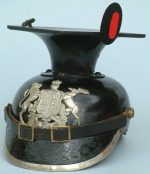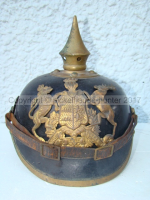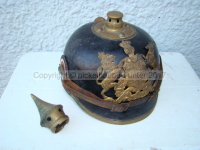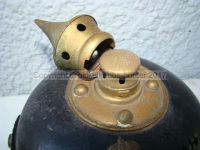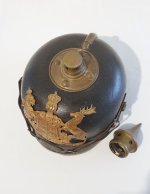You are using an out of date browser. It may not display this or other websites correctly.
You should upgrade or use an alternative browser.
You should upgrade or use an alternative browser.
Rare M15 Prusian first model Pickelhabe
- Thread starter Dries kroos
- Start date
And again. A proper 1915 Friedens-Uniform helmet.Here is my wurttemberg helmet with the detachable spike and the light brown liner. All fittings are in brass.
Inside the stamp IR 127.
Sandmann
Well-known member
Thank you Bruno and also Philippe, your explanations helped me a lot to get a better understanding of these helmets.I agree, Philippe, and would make the same comment. Since the detachable spike is the hallmark of the M15 helmet (September 1915), these models with grey fittings, black liners, and fixed spikes should not be seen as bona fide M15s, but rather ersatz models which, all variants included, were produced from the begining of the war. Transition to the M15 was officialized by the ordnance of April 1915 (pewter grey metal parts).
Sandmann
Well-known member
Bruno, do you mean the AKO Nr 275/1915, from April 6, 1915? But according to the text the order affected only buttons, Waist- and side-hooks, not helmet fittings or emblems. Or was there another AKO I didn’t find?Transition to the M15 was officialized by the ordnance of April 1915 (pewter grey metal parts).
argonne
Well-known member
Sandy, you are correct, I am referring to the AKO from April 6th, 1915, and only as a cross-reference to others, principally JL Larcade. This AKO is presented as the major step toward official adoption of gray metal uniform parts. Wouldn't it be strange to wear everything metallic in matt gray colour, but a bright shiny helmet?Bruno, do you mean the AKO Nr 275/1915, from April 6, 1915? But according to the text the order affected only buttons, Waist- and side-hooks, not helmet fittings or emblems. Or was there another AKO I didn’t find?
Tony, the big problem I see with your Wuertemberg Tschapka is that it is not in my collection (to paraphrase the late Adler).Bruno to my eyes your two Tschapka are superb examples of M1915 Friedens-Uniform helmets. Nothing transitional about them. This Württemberg Friedens-Uniform issued Tschapka is dated 1916.
View attachment 24045
I wonder how strict this distinction was, between field and peace uniforms, especially after the field AND peace variant was introduced in 1915. Were the Tschapkas and spike helmets pictured above made only for garrison and casual use? Then why bother having these removable tops instead of the classic pre-15 models? The Tschapka was clearly intended to be worn with an Ueberzug, since the top part of the mortarboard basis was already painted field-grey, similar to the later M15 model.
These are just naive questions of mine. I will leave answers to those much more expert in uniformology, as you are.
pickelhauben
Well-known member
I would love to have that Wurt with removable top .
Thanks for sharing.
Thanks for sharing.
Oooh! An expert! Very kind Bruno, but it seems the more I learn the less I know…..
What is interesting with the 1915 Friedens-Uniform, is that the Germans were confident enough in victory, to design and implement a peacetime uniform. Especially when they were already so short of strategic materials, such as brass and Neusilber. Honestly, it seems to me that any combination and variations of removable parts, seemed to have been tolerated. Does it sound reasonable, that the removable tops on Friedens-Uniform helmets, were so the helmets could be worn in future wars?
The 1915 helmets all seem such a waste of effort, planning, and production, when very quickly it was all abandoned for the Stahlhelme.
What is interesting with the 1915 Friedens-Uniform, is that the Germans were confident enough in victory, to design and implement a peacetime uniform. Especially when they were already so short of strategic materials, such as brass and Neusilber. Honestly, it seems to me that any combination and variations of removable parts, seemed to have been tolerated. Does it sound reasonable, that the removable tops on Friedens-Uniform helmets, were so the helmets could be worn in future wars?
The 1915 helmets all seem such a waste of effort, planning, and production, when very quickly it was all abandoned for the Stahlhelme.
Zebedeus
Well-known member
I'm sorry Tony, but I don't think I share your thoughts.And again. A proper 1915 Friedens-Uniform helmet.
The helmet looks exactly like a kammer model for use in campaign and garnison, it has the same materials and components as the mod. 1915, has a removable nail, the interior is in light natural leather, has the manufacturer's round mark, and the stamp of the 127th wurttemberg infantry regiment.
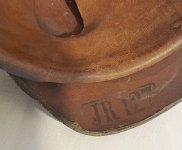
It differs only for the emblem and all the metal parts, which are in brass and not in feldgrau sheet iron.
At this time I have some doubts about it, as my friend Bruno has already written above.
On what knowledge do you claim to be a friedens-uniform helmet? Are there any regulations that I don't know about? Maybe.
What utility could the removable spike or morterboard have for a helmet not to be used in the countryside?
If it were a friedens-uniform helmet, why are there so few in our collections and museums?
There should be many more.
Normally the uniforms and headgear for friedens uniform are, with some exceptions, of private acquisition and not kammer. They do not have the stamps of the department and have a different quality of the materials.
The evolution of the 1915 model, at least from the documentation in our possession, is not yet clear.
Let's try together to make objective hypotheses. Help me friends.
AKO of April 06, 1915 Defines the use of feldgrau for military equipment.
As Sandmann wrote “ according to the text the order affected only buttons, Waist- and side-hooks, not helmet fittings or emblems.
AKO of June 28, 1915
a removable spike was introduced on a helmet substantially a mod. 1895
One example of this modified M1895 helmet is showed in the Musee militaire de la Targhette”
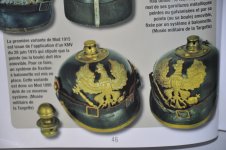
But Kraus claims : “… all helmet fittings were made of zinc-plated sheet iron in according with wartime economy”. Reference The german army by Jurgens Kraus)
25 August 1915 the experimental new model that will become the M1915 is proposed and accepted by the prussian Army.
AKO of 21 September 1915 Defines finally the adoption of the new model 15 as we all know it with the removable spike and feldgrau fittings.
11 November 1915 Adoption of the 1915 form by the Kingdom of Bavaria
AKO of 27 October 1916 The use of the gray cover is abolished with the exception of the Landsturm departments
My hypothesis is that in the period between April 1915 and September 1915, the various regulations that have followed one another at close range have created confusion in small producers, who may have received them not completely and correctly and perhaps with delay.
So were born some hybrids that did not have all the characteristics of the canonical 1915 mod, as we all know it.
This hypothesis of mine could also explain the existence of the earlier mod. 1915 helmet with the fixed and non-detachable spike, even if already with the feldgrau fittings.
It also occurs to me that in a war economy with a scarcity of materials, small producers have still used all the materials and accessories for the mods. 1895 to consummation for the production of the new model 1915. Could it be?
Occasionally you will come across some 1915 models with the blackened leather's liner or some helmets with side post M91 in silver or brass and feldgrau emblem.
Just my opinion and nothing more.
If anyone has or is aware of any elements to develop this interesting topic, please help us to do so.
What do you think about?
All hypotheses are welcome! Honestly, the reason I sold almost all of my Wartime Feldgrau, was because it is so confusing…. Your IR127 marked helmet is marvellous. First helmet I’ve ever seen in brass with a removable spike.I'm sorry Tony, but I don't think I share your thoughts.
Sandmann
Well-known member
According to the official orders I‘ve found in the army regulation sheets 1914 - 1916 the fittings were always to be made from Brass, Tombak, aluminum bronce or nickel silver. As far as I know there were also no regulations for steel fittings for helmets in war time or „Ersatz“ helmets, but as we know both exit.
Experiments with helmets made of felt, cardboard or a fabric-covered cork already took place a few years before the start of the First World War. The army also wanted to make the helmet covers superfluous with colored helmets and fittings. However, the results were not convincing, which is why the well-known M95 and the cover were retained.
So I think, like Tony, that the shortage of materials due to the immensely increased demand and the trade blockades caused the army command to reconsider these tests, because the replacement helmets corresponded pretty much exactly to all the test helmets mentioned above. However, since the helmets had already been tested in previous years and the reasons for rejection were comparatively minor (see: Zeitschrift für Heereskunde "Preussische Versuchshelme 1906 - 1914", by Jürgen Kraus), I can imagine that they were unofficially approved as replacement helmets without further testing.
Experiments with helmets made of felt, cardboard or a fabric-covered cork already took place a few years before the start of the First World War. The army also wanted to make the helmet covers superfluous with colored helmets and fittings. However, the results were not convincing, which is why the well-known M95 and the cover were retained.
So I think, like Tony, that the shortage of materials due to the immensely increased demand and the trade blockades caused the army command to reconsider these tests, because the replacement helmets corresponded pretty much exactly to all the test helmets mentioned above. However, since the helmets had already been tested in previous years and the reasons for rejection were comparatively minor (see: Zeitschrift für Heereskunde "Preussische Versuchshelme 1906 - 1914", by Jürgen Kraus), I can imagine that they were unofficially approved as replacement helmets without further testing.
Last edited by a moderator:
Sandmann
Well-known member
On this subject I also found an interesting article from 1915 on the shortage of materials and their replacement. It was published in the magazine „Kunststoffe“ (plastics) and I translated it for our community (source: „Kunststoffe“, year 1915 - www.archive.org):
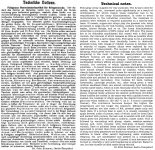

argonne
Well-known member
This suggestion may be not very far from the historical truth...Honestly, it seems to me that any combination and variations of removable parts, seemed to have been tolerated. Does it sound reasonable, that the removable tops on Friedens-Uniform helmets, were so the helmets could be worn in future wars?
The 1915 helmets all seem such a waste of effort, planning, and production, when very quickly it was all abandoned for the Stahlhelme.
Below is an anecdote from the Regimentsgeschichte of the badisches RJR111 concerning a missing M15 spike on a helmet stored in January 1917 in a Kammer behind the front:

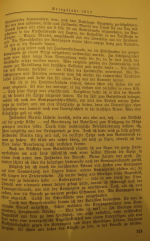
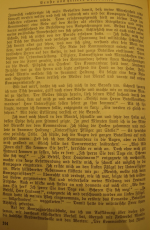
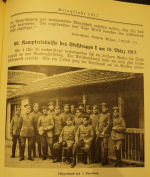
Brief translation but respecting the main lines and meaning of the book:
At the end of January 1917, Unteroffizier Wilhelm Pflüger, 7/RJR111 was taking part to a Minenwerfer training in Nantillois when he was ordered to go to the main camp behind the frontline in Beugeholz to attend a religious ceremony. The Feldwebel on duty informed him that the required dress was a coat with a belt over it and a Friedenshelm (helmet with a spike). Pflüger went to the Handwerker's barrack where all the company's "Friedenshelme" were stored, stacked on top of each other. Pflüger points out that these helmets had not been worn for a long time, as they had been replaced by the Stahlhelm in the trenches. However, the Pickelhauben continued to be part of the soldier's equipment and were kept in the Kammer barracks, each helmet bearing the name of the soldier.
When Pflüger appeared in the barrack, there was only one helmet left, his own, but it no longer had the unscrewable spike ( thus M15 helmet). Panicking at being the only one without a spike on the helmet during the church ceremony, he headed for the office to report the loss of his spike. The Feldwebel consoled him by telling him that because of the cold weather, the brigade had allowed him to wear the Krätzchen during the ceremony. However, the Feldwebel ordered him to go back to looking for his spike once the church ceremony was over. Somewhat disconcerted by this new order, Pflüger returned to the Kammer barrack, searched every nook and cranny, every drawer and finally found the missing spike in a hole in the floor after half an hour. Looking out of the window, he saw that in the meantime the whole battalion had gathered on the main place of the camp for a parade in honour of the Kaisers birthday, each comrade wearing the Friedenshelm on his head. The company commanders were already reporting to the battalion Hauptmann. Pflüger decided to return discreetly to his company barrack, which he naturally found empty. Thinking that no one would notice his absence, he followed the ceremony through one of the windows, first a speech in praise of His Majesty the Kaiser by the battalion commander, then a medal awarding to the troops, until the battalion commander suddenly stopped and called for the Leutnant, Pflüger's company commander. A soldier was immediately sent to the company barracks and Pflüger was ordered to come out and report to the battalion commander immediately. There followed a thunderstorm by the battalion commander and he ordered three days' arrest for Pflüger. After the parade, it was the company commander's turn to reprimand Pflüger a second time, also promising him three days' arrest.
Pflüger then went to the office and found his Feldwebel handing him the Badische Verdienstmedaille, telling him that the battalion commander had wanted to award him but that this had become impossible due to his absence. However, Pflüger did not have to endure his three days of arrest....
Philippe
Zebedeus
Well-known member
I completely agree with you Sandy.I believe if the German Empire had survived, the spiked helmet would still be worn by the guards at state visits or parades, as in Sweden, France or Great Britain. But I don’t think that the M15 was planned for future wars.
WOW, this is all excellent information and background history of the transition to the M15. Though its time at the front end, the Pickelhaube still lived in garrison and special civilian events such as weddings and funerals. Thank you all for the history lesson and fantastic photos of these rare helmets.
Best regards,
John
Best regards,
John

